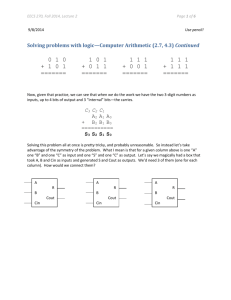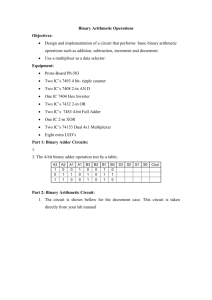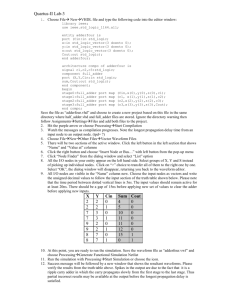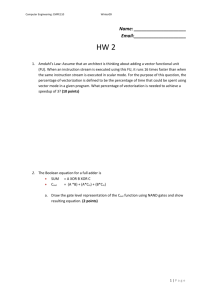Embedded Systems Project 9 - Designing Logic Circuits with
advertisement
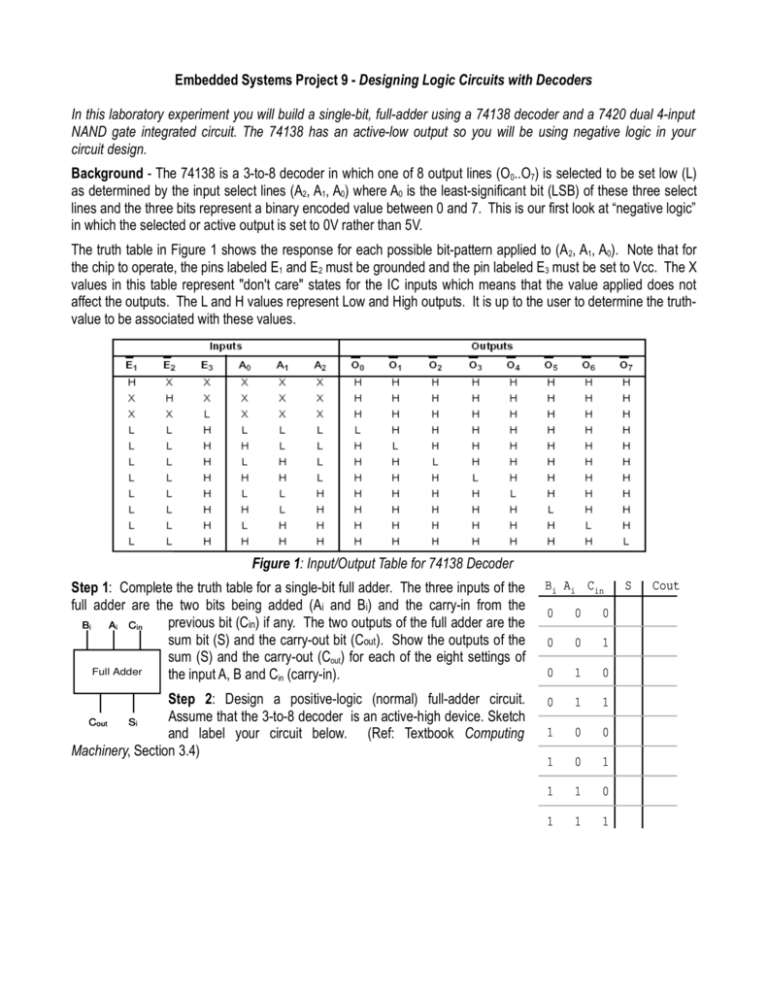
Embedded Systems Project 9 - Designing Logic Circuits with Decoders In this laboratory experiment you will build a single-bit, full-adder using a 74138 decoder and a 7420 dual 4-input NAND gate integrated circuit. The 74138 has an active-low output so you will be using negative logic in your circuit design. Background - The 74138 is a 3-to-8 decoder in which one of 8 output lines (O0..O7) is selected to be set low (L) as determined by the input select lines (A2, A1, A0) where A0 is the least-significant bit (LSB) of these three select lines and the three bits represent a binary encoded value between 0 and 7. This is our first look at “negative logic” in which the selected or active output is set to 0V rather than 5V. The truth table in Figure 1 shows the response for each possible bit-pattern applied to (A 2, A1, A0). Note that for the chip to operate, the pins labeled E1 and E2 must be grounded and the pin labeled E3 must be set to Vcc. The X values in this table represent "don't care" states for the IC inputs which means that the value applied does not affect the outputs. The L and H values represent Low and High outputs. It is up to the user to determine the truthvalue to be associated with these values. Figure 1: Input/Output Table for 74138 Decoder Step 1: Complete the truth table for a single-bit full adder. The three inputs of the full adder are the two bits being added (Ai and Bi) and the carry-in from the previous bit (Cin) if any. The two outputs of the full adder are the Bi Ai Cin sum bit (S) and the carry-out bit (Cout). Show the outputs of the sum (S) and the carry-out (Cout) for each of the eight settings of Full Adder the input A, B and Cin (carry-in). Bi Ai Cin Step 2: Design a positive-logic (normal) full-adder circuit. Assume that the 3-to-8 decoder is an active-high device. Sketch Cout Si and label your circuit below. (Ref: Textbook Computing Machinery, Section 3.4) 0 0 0 0 0 1 0 1 0 0 1 1 1 0 0 1 0 1 1 1 0 1 1 1 S Cout Step 3: As stated earlier the 74138 provides an active low output (negative logic). This means that the selected output line is low while the other seven output lines are high (Vcc). For this reason we will not use OR gates to accumulate the selected outputs for the sum (S) and carry out (Cout) functions. We could pass each output through a NOT gate to convert the 74138 to active high, but this would require eight inverters (or two 7404 ICs). Instead we will replace the OR gates in the positive-logic circuit design with NAND gates. Note that NAND gates have a low output only if all inputs are high, therefore they can be used to convert the negative logic output of the 74138 back to positive logic. Replace the OR gates in your circuit with 4-input NAND gates provided in the 7420. Implement your circuit using the 74138 and 7420. The pinouts for these two ICs are shown in Figure 2. Step 4: Test your circuit by applying binary encoded values 000 through 111 to the select lines of the 74138. These data can be generated using the Arduino processor board running the three_variable_generator. You should test both the sum (S) and the carry out (Cout) for all combinations of A, B and Cin. Debug your circuit if necessary before continuing. Figure 2: Pinout Diagrams for 74138 and 7420 Step 5: Get with three other students (if available) and join your circuit with other completed full adders in the lab to make a 4-bit adder circuit as shown in Figure 3. This type of binary adder is called a ripple-carry adder because the carry-out bit value can ripple through the full-adders from the LSB to the most-significant-bit. B3 A3 Cin B2 A2 Cin B1 A1 Cin B0 A0 Cin set to 0 Full Adder Cout S3 Full Adder Cout S2 Full Adder Cout S1 Full Adder Cout S0 Figure 3: Four-Bit Ripple Carry Adder 1. How many different three-variable Boolean expressions can be implemented using a 74138 decoder? _______ Explain____________________________________________________________________________________ 2. The 74138 accepts a 3-bit binary encoded value to select one of the 23=8 output lines. Describe how you could use two 74138s to build a 4-bit to 24=16 line decoder. Hint: Use the high-order bit of the 4-bit selector value to choose which 74138 is active using the E (enable) lines. _____________________________________________________ _____________________________________________________ _____________________________________________________ _____________________________________________________ _____________________________________________________ _____________________________________________________ circuit sketch


